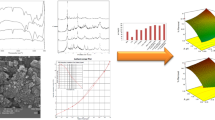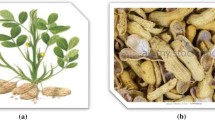Abstract
The presence of heavy metals in aqueous streams arising from the discharge of industrial effluents into water bodies is one of the most important environmental issues because of their toxic nature and its removal is highly essential. This paper deals with the adsorption studies for the removal of hexavalent chromium ions from aqueous solutions using Schiff based chitosan activated carbonized rice husk composites as adsorbent. The activation and surface properties of the adsorbent were characterized by Scanning Electron Microscopy (SEM), Fourier transform infrared spectroscopy (FTIR), and Brauner Emmet and Teller (BET) analyzer. Central Composite Design (CCD) was used to optimize the process variables such as initial metal ion concentration, adsorbent dosage and pH of the solution on the performance of percentage removal and adsorption capacity. The experimental data were validated with different isotherms and kinetic models to evaluate the solute interaction behavior and nature of adsorption.











Similar content being viewed by others
References
Abdullah AZ, Salamatinia B, Kamaruddin AH (2009) Application of response surface methodology for the optimization of NaOH treatment on oil palm frond towards improvement in the sorption of heavy metals. Desalination 244:227–238
Ahmad AA, Hameed BH, Ahmad AL (2009) Removal of disperse dye from aqueous solution using waste-derived activated carbon: optimization study. J Hazard Mater 170:612–619
Arulkumar M, Sathishkumar P, Palvannan T (2011) Optimization of orange G dye adsorption by activated carbon of Thespesia populnea pods using response surface methodology. J Hazard Mater 186:827–834
Attia AA, Khedr SA, Elkholy SA (2010) Adsorption of chromium ion (VI) by acid activated carbon. Braz J Chem Eng 27:183–193
Babu BV, Gupta S (2008) Adsorption of Cr(VI) using activated neem leaves kinetic studies. J Adsorpt 14:85–92
Bashir MJK, Aziz HA, Yusoff MS, Adlan MN (2010) Application of response surface methodology (RSM) for optimization of ammoniacal nitrogen removal from semi-aerobic landfill leachate using ion exchange resin. Desalination 254:154–161
Chatterjee S, Lee D, Lee S, Woo SH (2009) Congo red adsorption from aqueous solutions by using chitosan hydrogel beads impregnated with nonionic or anionic surfactant. Bioresour Technol 100:3862–3868
Cronje KJ, Chetty K, Carsky M, Sahu JN, Meikap BC (2011) Optimization of chromium (VI) sorption potential using developed activated carbon from sugarcane bagasse with chemical activation by zinc chloride. Desalination 275:276–284
Demirbas E, Kobya M, Senturk E, Ozkan T (2004) Adsorption kinetics for the removal of chromium(VI) from aqueous solutions on the activated carbons prepared from agricultural wastes. Water SA 30:533–540
Dutta S, Bhattacharyya A, Ganguly A, Gupta S, Basu S (2011) Application of response surface methodology for preparation of low-cost adsorbent from citrus fruit peel and for removal of methylene blue. Desalination 275:26–36
El-Ashtoukhy Z, Amin ES, Abdelwahab NK (2008) Removal of lead(II) and copper(II) from aqueous solution using pomegranate peel as a new adsorbent. Desalination 223(223):162–173
Garg UK, Kaur MP, Sud D, Garg VK (2009) Removal of hexavalent chromium from aqueous solution by adsorption on treated sugarcane bagasse using response surface methodological approach. Desalination 249:475–479
Guo Y, Qi J, Yang S, Yu K, Wang Z, Xu H (2002) Adsorption of Cr(VI) on micro- and mesoporous rice husk-based active carbon. Mater Chem Phys 78:132–137
Hai-Jun L, Mao-Tian L, Jin-Li Z (2009) A kinetic study on the adsorption of Cr (VI) onto a natural material used as land fill liner. Electron J Geotech Eng 14:1–10
Hsu ST, Pan TC (2007) Adsorption of paraquat using methacrylic acid-modified rice husk. Bioresour Technol 98:3617–3621
Jiang W, Su H, Huo H, Tan T (2010) Synthesis and properties of surface molecular imprinting adsorbent for removal of Pb2+. Appl Biochem Biotechnol 160:467–476
Kalavathy HM, Regupathi I, Pillai MG, Miranda LR (2009) Modelling, analysis and optimization of activation parameter of H3PO4 activated rubber wood saw dust using response surface methodology (RSM). Colloids Surf B 70:35–45
Khan NA, Ibrahim S, Subramaniam P (2004) Elimination of heavy metals from wastewater using agricultural wastes as adsorbents. Malays J Sci 23:43–51
Kumar R, Singh R, Kumar N, Bishnoi K, Bishnoi NR (2009) Response surface methodology approach for optimization of biosorption process for removal of Cr(VI), Ni (II) and Zn (II) ions by immobilized bacterial biomass sp. Bacillus brevis. Chem Eng J 146:401–407
Lee JM, Palanivelu K, Lee YS (2008) Removal of hexavalent chromium on chitosan-deposited activated carbon. Solid State Phenom 135:85–88
Malik R, Ramteke DS, Wate SR (2007) Adsorption of malachite green on groundnut shell waste based powdered activated carbon. Waste Manage 27:1129–1138
Martin-Lara MA, Rodriguez IL, Blazquez G, Calero M (2011) Factorial experimental design for optimizating the removal conditions of lead ions from aqueous solutions by three wastes of the olive-oil production. Desalination 278:132–140
Nameni M, Moghadam MRA, Arami M (2008) Adsorption of hexavalent chromium from aqueous solutions by wheat bran. Int J Environ Sci Technol 5:161–168
Nomanbhay SM, Palanisamy K (2005) Removal of heavy metal from industrial wastewater using chitosan coated oil palm shell charcoal. Electron J Biotechnol 8:43–53
Park D, Yun YS, Lee DS, Park JM (2011) Optimum condition for the removal of Cr(VI) or total Cr using dried leaves of Pinus densiflora. Desalination 271:309–314
Sahu JN, Acharya J, Meikap BC (2009) Response surface modelling and optimization of chromium(VI) removal from aqueous solution using tamarind wood activated carbon in batch process. J Hazard Mater 172:818–825
Saueprasearsit P (2011). Adsorption of chromium (Cr + 6) using durian peel. International conference on biotechnology and environment management IPCBEE 18
Sindhu M, Begum KMMS, Sugashini S (2012) A comparative study of surface modification in carbonized rice husk by acid treatment. Desalination Water Treat 45:170–176
Singh KP, Singh AK, Gupta S, Sinh S (2011) Optimization of Cr(VI) reduction by zero-valent bimetallic nanoparticles using the response surface modelling approach. Desalination 270:275–284
Tanyildizi MS (2011) Modeling of adsorption isotherms and kinetics of reactive dye from aqueous solution by peanut hull. Chem Eng J 168:1234–1240
Wu FC, Tseng RL, Juang RS (2002) Adsorption of dyes and humic acid from water using chitosan-encapsulated activated carbon. J Chem Technol Biotechnol 77:1269–1279
Zhu S, Yang N, Zhang D (2009) Poly (N,N-dimethylaminoethyl methacrylate) modification of activated carbon for copper ions removal. Mater Chem Phys 113:784–789
Author information
Authors and Affiliations
Corresponding author
Rights and permissions
About this article
Cite this article
Sugashini, S., Begum, K.M.M.S. Optimization using central composite design (CCD) for the biosorption of Cr(VI) ions by cross linked chitosan carbonized rice husk (CCACR). Clean Techn Environ Policy 15, 293–302 (2013). https://doi.org/10.1007/s10098-012-0512-3
Received:
Accepted:
Published:
Issue Date:
DOI: https://doi.org/10.1007/s10098-012-0512-3




